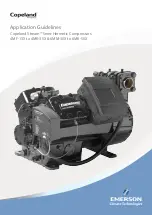
Reference
Description
F
Dry compressed air (Full-Feature)
Air flow
Air comes in through filter (AF) and inlet valve (IV) and is compressed in the compressor element (E).
A mixture of compressed air and oil flows into the air receiver/oil separator (AR).
The air flows through the minimum pressure valve (Vp), the air cooler (Ca) and the condensate trap (MT)
to the outlet valve (AV).
Minimum pressure valve (Vp) prevents the receiver pressure from dropping below a minimum pressure
and includes a check valve which prevents blow-back of compressed air from the net.
Full-Feature compressors have a dryer (DR) after the air cooler.
Oil circuit
The air receiver (AR) removes most of the oil from the air/oil mixture by centrifugal action. The oil
separator (OS) removes the remaining oil. The oil collects in the lower part of the air receiver (AR) which
serves as oil tank.
The oil system has a thermostatic bypass valve (BV).
When the oil temperature is below 71 ˚C (160 ˚F), the bypass valve shuts off the oil supply from the oil
cooler (Co).
Air pressure forces the oil from air receiver (AR) through the oil filter (OF). The oil cooler (Co) is
bypassed.
When the oil temperature has increased up to 71˚C (160 ˚F), bypass valve (BV) starts opening the supply
from the oil cooler (Co). At approximately 85˚C (185 ˚F), all the oil flows through the oil cooler.
The filtered oil flows through the cooling channels of the interior permanent magnet (iPM) motor to the
compressor element (E).
Cooling
The cooling system has an air cooler (Ca) and an oil cooler (Co).
The fan (FN) blows air over the coolers. This fan is set on and off, depending on the operating conditions,
according to a specific algorithm.
2.3
Condensate system
Drain connections
The compressors have an electronic water drain (ED).
Instruction book
16
2920 7109 23
















































